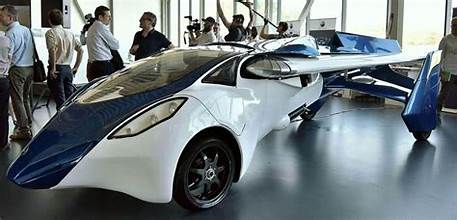In the ever-evolving landscape of transportation, the concept of the “fly car” has captured the imaginations of engineers, futurists, and enthusiasts alike. This transformative idea envisions a future where vehicles transcend the constraints of roads, taking to the skies to revolutionize the way we move from place to place. As we delve into the realm of fly cars, we explore the technology behind them, potential challenges, and the impact they may have on our daily lives.
The Technological Marvel:
The foundation of the fly car lies in cutting-edge technology that blends elements of aviation and automotive engineering. These vehicles are designed to seamlessly transition between driving on roads and flying in the air, offering a dual-mode of transportation unparalleled in history.
Key Technological Components:

- Vertical Takeoff and Landing (VTOL) Capability: Fly cars are equipped with VTOL technology, allowing them to ascend and descend vertically. This eliminates the need for traditional runways or airports, enabling takeoff and landing in confined urban spaces.
- Electric Propulsion Systems: Many fly cars leverage electric propulsion systems, contributing to sustainability and reduced environmental impact. Electric motors provide the necessary power for both road and air travel, offering a clean and efficient mode of transportation.
- Advanced Navigation and Autonomy: Navigation systems in fly cars integrate advanced algorithms and GPS technology, ensuring precise control during both flying and driving modes. Autonomy features play a crucial role, enabling safe and efficient operations without relying solely on human piloting skills.
- Convertible Design: The transformative nature of fly cars is reflected in their convertible design. Wings or rotors unfold for flight mode, while they retract for conventional driving. This adaptability is a key feature that distinguishes fly cars from traditional vehicles.
Challenges and Considerations:
While the concept of fly cars is undeniably futuristic and exciting, it comes with its share of challenges and considerations that must be addressed for widespread adoption.
- Regulatory Frameworks: The integration of fly cars into existing airspaces and road networks requires robust regulatory frameworks. Authorities must establish rules for airspace management, licensing, and safety standards to ensure the seamless integration of these vehicles into our daily lives.
- Infrastructure Development: The introduction of fly cars demands significant investments in infrastructure. Vertiports, designated areas for takeoff and landing, need to be strategically placed in urban environments. Additionally, road networks must be equipped to handle the increased complexity of traffic management.
- Safety and Certification: Ensuring the safety of fly cars is paramount. Rigorous certification processes, akin to those for aircraft, must be established. This includes comprehensive testing for both airworthiness and roadworthiness to meet stringent safety standards.
- Public Perception and Acceptance: The acceptance of fly cars by the general public is a crucial factor. Education and communication campaigns will be essential to dispel any apprehensions and build trust in the safety and reliability of this novel mode of transportation.
The Impact on Urban Mobility:
The advent of fly cars promises a transformative impact on urban mobility, addressing challenges posed by increasing population density and traffic congestion. Here are some key ways in which fly cars may reshape the way we navigate our cities:
- Reduced Traffic Congestion: By taking to the skies, fly cars have the potential to alleviate ground-level traffic congestion. This could lead to faster and more efficient transportation, particularly in densely populated urban areas.
- Time Efficiency: Fly cars offer the advantage of faster point-to-point travel, bypassing traditional road routes. This time efficiency could revolutionize daily commutes and significantly reduce travel times.
- Access to Remote Areas: Fly cars could provide access to remote or hard-to-reach areas, contributing to improved connectivity. This could be particularly impactful in emergency situations, facilitating rapid response and aid delivery.
- Environmental Considerations: The electric propulsion systems of fly cars contribute to a cleaner and greener urban environment. Reduced reliance on traditional fossil fuels aligns with the global push for sustainable transportation solutions.
- Urban Planning Reimagined: The introduction of fly cars necessitates a reimagining of urban planning. Vertiports and designated air corridors must be integrated into city layouts, influencing the design and structure of urban spaces.
The Future of Fly Cars:
As we gaze into the future, the concept of fly cars presents a compelling vision for the evolution of transportation. While still in the early stages of development and testing, numerous companies and innovators are actively pursuing the realization of this futuristic mode of travel.
- Industry Players: Several prominent companies, including aerospace giants and startups, are investing heavily in fly car technology. These include companies like Airbus, Uber Elevate, and Terrafugia, each bringing unique perspectives and innovations to the table.
- Prototype Testing: Prototypes of fly cars have undergone successful test flights and road trials, showcasing the tangible progress made in bringing this vision to life. These tests are crucial in refining the technology and addressing potential challenges.
- Collaboration and Partnerships: The development of fly cars often involves collaboration between different industries. Aerospace engineers, automotive experts, and urban planners work together to create a holistic solution that seamlessly integrates into existing transportation ecosystems.
Conclusion:
The journey towards the widespread adoption of fly cars is an exciting and complex one. While challenges loom on the horizon, the potential benefits in terms of efficiency, reduced congestion, and environmental sustainability are too compelling to ignore. As technology continues to advance and regulatory frameworks take shape, the skies may indeed become the next frontier for urban mobility, ushering in a new era of transportation that transcends the bounds of the roads we’ve known for centuries. The dream of flying cars, once relegated to the realm of science fiction, is now poised to soar into reality, shaping the future of how we move and connect in our ever-evolving world.